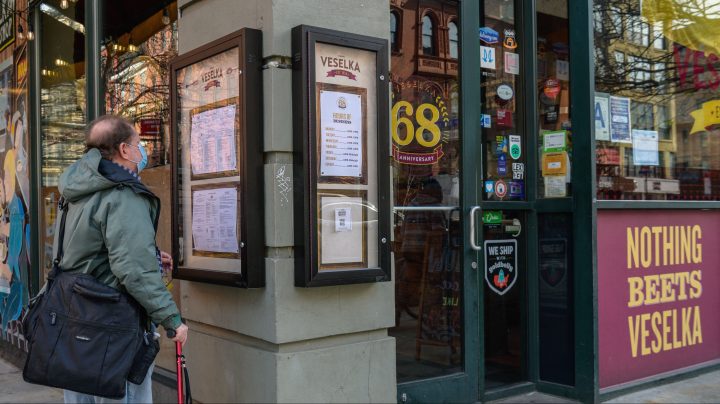
Quiet dread coats daily life in NYC’s Little Ukraine

New York City is home to one of the largest populations of Ukrainians in the United States, somewhere between 100 and 150,000, according to the Ukrainian Congress Committee of America. And the longtime heart of that community is Little Ukraine, a handful of blocks in Manhattan’s East Village neighborhood identifiable by its Ukrainian restaurants, churches and banks.
The streets of Little Ukraine were eerily quiet on a recent weekday. The Ukrainian Americans there were quiet, too. A distressed bank teller did not want to talk. A restaurant worker who said he hadn’t slept in days and was too overwhelmed to talk on tape gave a tired fist bump.
Signs hanging outside the Ukrainian Museum read “We stand with Ukraine.” Candles rested on the steps of a nearby church. Blue and yellow flags were everywhere. Veselka, a popular Ukrainian diner, painted its cookies the national colors.
Christine Karpevych was eating lunch from Veselka, part of her weekly routine. “Stuffed cabbage with meat and sauerkraut and kasha,” she said.
The restaurant offered particular comfort on this day. Karpevych, 86, emigrated from Lviv in 1949. She said she woke up feeling very anxious.
“But I’ve been feeling very anxious for a while now. Putin does this psychological war. I mean he wants to destroy people’s spirit even before he attacks them,” she said.
Veselka was busy, with a steady stream of customers from all backgrounds coming to eat Ukrainian comfort food. “I’m exceptionally busy since I opened the doors this morning at 8 a.m.,” said Jason Birchard, Veselka’s owner.
The restaurant has been in his family, and in the East Village, for 68 years. Birchard’s grandfather emigrated from Ukraine in the 1940s. A lot of the staff at the restaurant is Ukrainian, too.
“I mean, we’re a small community here, but most everybody can identify with Ukraine to some extent,” Birchard said.
It’s a small community, but its presence is big. Sofika Zielyk, a member of the Ukrainian National Women’s League of America, grew up in the East Village, too.
“Ukrainian is my first language. And till I was about 4 or 5, I didn’t know there was another language in the United States. I went to a Ukrainian Catholic grammar school and high school. We had our own little community,” Zielyk said.
She said “had” because many Ukrainians have left the area as the neighborhood changed. “But we are still here, and there are days where I walk on the street and I hear Ukrainian. I hear very little English,” she said.
Zielyk said in recent weeks the community has been coming together to protest and raise money. That’s helped her feel supported while she checks in on friends in Eastern Ukraine, who are messaging her from subway stations that have become bomb shelters. But the Ukrainians she’s most worried about live in her very apartment building: her parents. They, like a lot of Ukrainians, are reliving the memories of what drove them here decades ago.
“My mother, who is 88 years old, is now reliving her war years during WWII. She thinks about herself as a 10-year-old girl hiding. That is something that is very difficult to see,” she said.
There’s a lot happening in the world. Through it all, Marketplace is here for you.
You rely on Marketplace to break down the world’s events and tell you how it affects you in a fact-based, approachable way. We rely on your financial support to keep making that possible.
Your donation today powers the independent journalism that you rely on. For just $5/month, you can help sustain Marketplace so we can keep reporting on the things that matter to you.











